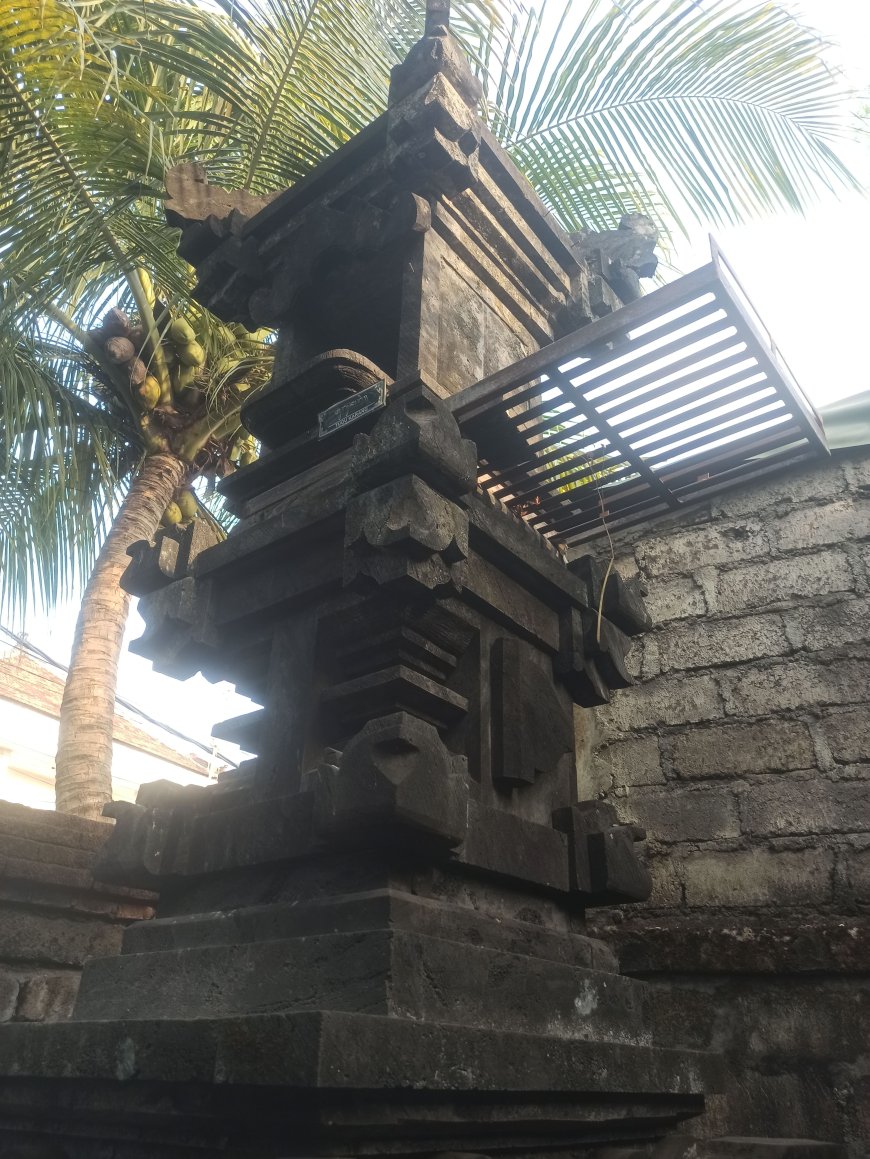Penunggun Karang : A Strong Fortress of Skala and Niskala of Balinese Hindu Society
Did you know that in every Balinese Hindu house there is a monument that is always built by the community on the west side of their house? this is "Penunggun Karang", a monument that was built with what purpose? what is the role that accompanies it? How did it originate? Let's explore together in this article!

Balinese Hindus believe that every sacred building or Pelinggih pasri is designated according to its function and use. The sacred building or Pelinggih is believed to be the Stana of the Goddess or Ida Bhatara or Linggih the holy spirit of the ancestors. The existence of the shrine or pelinggih is a place for humans to establish a relationship with the abstract realm. In general, Balinese houses have two sacred buildings that have a function as representatives of residents in the abstract realm. The two places are Sanggah Pengijeng Karang (Penunggun Karang) and Sanggah Pemerajan. For Hindus, especially in Bali, Sanggah Penunggun Karang or also known as Palinggih Pangijeng is one of the sacred places in their yard. Penunggun Karang usually has a function as a sedahan guarding the coral or palemahan and its inhabitants to always be under the protection of Ida Sang Hyang Widhi Wasa, safe, peaceful, and rahayu, both in sekala and niskala.
When viewed from the syllables, Penunggun Karang or Tugu Karang comes from two syllables, namely the word Tugu which means to know/know/knowledgeable and the word Karang which means yard/yard or coral body. In Hinduism, it is believed that anyone who knows his/her body well will prosper, both in terms of sekala and niskala. If traced further, Penunggun Krang has a relationship with Kanda Pat, the four spiritual brothers or families that exist in everyone. The family referred to in this case can be a physical family that lives within the walls of a house or compound, while Pat Kanda or a mystical family that lives in a mystical realm. The compound is the placenta which is referred to as Prajapati and resides in Sedehan Karang.
If translated literally, then Pelinggih Penunggun Karang can be interpreted as a temple or sacred building for the guardian of the house. In some Susastra it is explained that in Pelinggih Penunggun Karang the one who is worshipped there is Hyang Bahurekso, meaning that he is the ruler of nature in the abstract of the place or region. All natural rulers such as Hyang Bahurekso are identified with Lord Ganesha. Thus, Hyang Bahurekso is grouped into the Ganabala or Gana army, the soldiers of Lord Ganesha.
In Lontar Sudhamala, it is mentioned that Ida Sang Hyang Widhi Wasa descended to the world in two manifestations, namely Sang Hyang Titah and Sang Hyang Wenang. Sang Hyang Titah is a manifestation of Ida Sang Hyang Widhi Wasa who controls the mystical realm, including the realm of Gods, the realm of Bhuta Kala, Heaven and Hell. He has the title Bhatara Siwa which is then referred to as Hyang Guru. Meanwhile, Hyang Wenang descends to Marcapada to rule the realm in the form of a semar or in Balinese literature called Malen who will carry out and nurture the contents of this world. Hyang Titah resides upstream, in the Sanggah Pemerajan complex. Meanwhile, Hyang Wenang resides in teben, which is a residential building complex in the form of a coral penunggun.
In another source, it is mentioned that the Penunggun Karang is the Stana of Ratu Made Jelawung. After receiving grace from Dewa Sangkara, Ratu Made Jelawung's embodiment became Bhatara Dukuh Sakti. This is where he has the task of being the God of Wates or fences, the protective God of everything, and as the God of light, both for Bhuana Agung and Bhuana Alit in the yard of the house. There are also those who say that Pelinggih Penunggun Karang is the Stana of Dewi Durga in her embodiment as Sang Hyang Durga Manikmaya or known as Sang Hyang Cili Manikmaya. As well as the Stana of Bhatara Kala called Sangkala Raksa who leads Sang Raksa, Adi Raksa and Rudra Raksa.
The Lontar Sapuh Leger tells that a king named Raja Sang Arjuna Sastrabahu fought with Bhatara Kala. In the war, Bhatara Kala lost against King Sang Arjuna Sastrabahu. Because of the defeat, Bhatara Kala finally surrendered and King Sang Arjuna Sastrabahu commissioned Bhatara Kala with the following directions: Duh Bhatara Kala mangke ring wayabya ungguhanta, wus we angrebeda ring rat. This means "Bhatara Kala, now in the Northwest (Wayabya), your duty is to keep you from disturbing human life". Since then, Bhatara Kala, who resides in the Pelinggih Penunggun Karang, is called Sang Kala Raksa who leads Sang Raksa, Adi Raksa and Rudra Raksa.
The place or position of the Penunggun Karang can be placed anywhere that still includes the position of teben if what is considered upstream is Sanggah Kemulan. However, it is better if it is placed near the gate of the house because the Penunggun Karang functions as a guardian of the house yard. If this is not possible, it may be erected in other places as long as it still fulfills the aspects of sanctity. In Lontar Hasta Kosala Kosali it is mentioned that Wayabya natar ika, iku Panunggun Karang paumahan, meaning "In the northwest (Wayabya) of the housing natar is the place of worship of Penunggun Karang".

Penunggun Karang that is Located in the North West of the Yard Area (Source : Personal Collection)
Hindus, especially those in Bali, are required to have a Sanggah Penunggun Karang because it is believed to protect the occupants of the house from various black magic attacks by giving banten to provide maximum protection from Penunggun Karang. Penunggun Karang is usually occupied or visited by Hyang who is assigned to be able to provide protection to the residents of the house and protect the yard. Usually the owner of the house will perform the nunas baos ritual to communicate and know the name of the guardian who resides in the Tugu Pelinggih and the surrounding area. In scale, it is believed that they have the ability to protect the house from the evil intentions of others, such as thieves, by changing or eliminating their evil intentions. They can also appear spooky or cause discomfort to ill-intentioned individuals, albeit without the use of medical methods and cause those ill-intentioned people to become non-medically ill.
In the niskala (invisible realm), Penunggun Karang will function as pecalang or niskala guards who will always guard the house yard. The process of establishing Pelinggih Penunggu Karang can be explained in the following stages. First, making the foundation hole (Ngeroak). At this stage, the foundation hole is made which has a meaning to change the status of the land from ordinary to holy. This is the first step in the process of establishing the temple. Second, the measurement of the location (Nyukat Karang). This step involves measuring the location where the coral-waiting shrine will be erected. This is important to determine the right place according to traditional beliefs.
Third, base making (Nasarin). At this stage, the base of the shrine is built. This creates the foundation for the pelinggih structure to be built. Fourth, the construction of the pelinggih (Memakuh). This step involves the construction or installation of the coral waiting shrine itself. This is the core of the construction of the temple. Fifth, the livelihood of the pelinggih (Ngurip). In this stage, the coral-waiting shrine is brought to life or given spiritual life. This can involve a series of rituals and ceremonies.
Sixth, cleansing and purification (Melaspas). This step is concerned with cleaning and purifying the place where the newly built coral awaiting shrine is located. Seventh, Ngenteg Linggih. At this stage, the coral temple is ensured to stand upright and strong. This also relates to the manifestation of God or the spiritual power represented by the pelinggih. Eighth, the Piodalan ceremony. The final step is the execution of the worship ceremony or piodalan. After God has been represented in the coral awaiting pelinggih, devotees are expected to offer offerings and respect according to their religious traditions.





























































